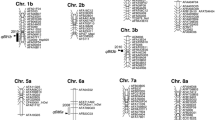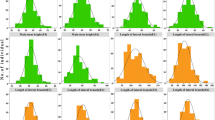Abstract
The tuberous stem of kohlrabi is an important quantitative trait, which affects its yield and quality. Genetic control of this trait has not yet been unveiled. To identify the QTLs controlling stem swelling of kohlrabi, a BC1 population of 92 plants was developed from a cross of broccoli DH line GCP04 and kohlrabi var. Seine. A wide range of variation in tuberous stem diameter was observed among the map** populations. We constructed a genetic map of nine linkage groups (LGs) with different types of markers, spanning a total length of 913.5 cM with an average marker distance of 7.55 cM. Four significant QTLs for radial enlargement of kohlrabi stem, namely, REnBo1, REnBo2, REnBo3, and REnBo4 were detected on C02, C03, C05, and C09, respectively, and accounted for the phenotypic variation of 59% for the stem diameter and 55% for the qualitative grading of tuberous stem in classes. Then, we confirmed the stability of identified QTLs using BC1S1 populations derived from the BC1 plants having heterozygous alleles at the target QTL and homozygous kohlrabi alleles at the remaining QTLs. REnBo1and REnBo2 using 128 plants of BC168S1 and 94 plants of BC143S1, respectively, and REnBo3 and REnBo4 using 152 plants of BC157S1 were detected at the same positions as the respective QTLs of the BC1 population. Confirmation of QTLs in two successive generations indicates that the QTLs are persistent. The QTLs obtained in this study could be useful in marker-assisted selection of kohlrabi breeding, and to understand the genetic mechanisms of stem swelling and storage organ development in kohlrabi and other Brassica species.




Similar content being viewed by others
References
Ayele MHB, Kumar N, Wu H, **ao Y, Aken SV, Utterback TR, Wortman JR, White OR, Town CD (2005) Whole genome shotgun sequencing of Brassica oleracea and its application to gene discovery and annotation in Arabidopsis. Genome Res 15:487–495
Baggett JR, Kean D (1989) Segregation for heading date and stem enlargement in kohlrabi × broccoli crosses. Euphytica 42:171–176
Cheng F, Sun R, Hou X, Zheng H, Zhang F, Zhang Y et al (2016) Subgenome parallel selection is associated with morphotype diversification and convergent crop domestication in Brassica rapa and Brassica oleracea. Nat Genet 48:1218–1224
Choi S, Ryu D, Park S, Ahn K, Lim Y, An G (2010) Composition analysis between kohlrabi (Brassica oleraceavar. gongylodes) and radish (Raphanus sativus). Korean J Hortic Sci Technol 28:469–475
Doerge RW, Churchill GA (1996) Permutation tests for multiple loci affecting a quantitative character. Genet 142:285–294
Fuller DQ et al (2014) Convergent evolution and parallelism in plant domestication revealed by an expanding archaeological record. Proc Natl Acad Sci USA 111:6147–6152
Gancheva MS, Dodueva IE, Lebedeva MA, Tvorogova VE, Tkachenko AA, Lutova LA (2016) Identification, expression, and functional analysis of CLE genes in radish (Raphanus sativus L.) storage root. BMC Plant Biol 16:23–33
Gao M, Li G, Yang B, Qiu D, Farnham M, Quiros C (2007) High-density Brassica oleracea linkage map: identification of useful new linkages. Theor Appl Genet 115:277–287
Gao F, Hirani AH, Liu J, Liu Z, Fu G, Wu C, McVetty PBE, Li G (2014) Fine map** a club root resistance locus in Chinese cabbage. J Am Soc Hortic Sci 139:247–252
Haberer G, Mayer KFX (2015) Barley: from brittle to stable harvest. Cell:469–471. doi:10.1016/j.cell. 2015.07.023
Havis AL (1940) A developmental analysis of kohlrabi and cabbage stem. J Agricul Res 61:459–470
Hovav R, Chaudhary B, Udall JA, Flagel L, Wendel JF (2008) Parallel domestication, convergent evolution and duplicated gene recruitment in allopolyploid cotton. Genetics 179:1725–1733
Iwata H, Ninomiya S (2006) AntMap: constructing genetic linkage maps using an ant Colony optimization algorithm. Map**. Breeding Sci 56:371–377
Jang G, Lee J, Rastogi K, Park S, Oh S, Lee J (2015) Cytokinin-dependent secondary growth determines root biomass in radish (Raphanus sativus L.) J Exp Bot 66:4607–4619
Javed N, Geng J, Tahir M. McVetty PBE, Li G, Duncan RW (2016) Identification of QTL influencing seed oil content, fatty acid profile and days to flowering in Brassica napus L. Euphytica 207:191-211
Kishore RN, Mangilal T, Anjaneyulu N, Abhinayani G, Sravya N (2014) Investigation of anti-urolithiatic activity of Brassica oleracea Gongylodes and Desmostachya Bipinnata in experimentally induced urolithiasis in animal models. Int J Pharm Pharm Sci 6:602–604
Kubo N, Saito M, Tsukazaki H, Kondo T, Matsumoto S, Hirai M (2010) Detection of quantitative trait loci controlling morphological traits in Brassica rapa L. Breeding Sci 60:164–171
Lan TH, Paterson AH (2000) Comparative map** of quantitative trait loci sculpting the curd of Brassica oleracea. Genetics 155:1927–1954
Lan TH, Paterson AH (2001) Comparative map** of QTLs determining the plant size of Brassica oleracea. Theor Appl Genet 103:383–397
Lenser T, Theiben G (2013) Molecular mechanisms involved in convergent crop domestication. Trends Plant Sci 18:704–714
Li C, Zhou A, Sang T (2006) Rice domestication by reducing shattering. Science 311(5769):1936–1939. doi:10.1126/science.1123604
Li J, Zou X, Zhang L, Cao L, Chen L (2016) Linkage map construction using SSR markers and QTL analyses of stem expansion traits in Brassica juncea. Sci Hortic 209:67–72
Lim TK (2015) Edible medicinal and non-medicinal plants. In: Modified stems, roots, bulbs, vol 9. Springer, Dordrecht. doi:10.1007/978-94-017-9511-1
Lou PJ, Zhao JS, Kim S, Shen DP, Carpio D, Song X, ** M, Vreugdenhil D, Wang X, Koornneef M, Bonnema G (2007) Quantitative loci for flowering time and morphological traits in multiple populations of Brassica rapa. J Exp Bot 58:4005–4016
Lu G, Cao J, Yu X, ** QTLs for root morphological traits in Brassica rapa L. based on AFLP and RAPD markers. J Appl Genet 49:23–31
Lv H, Wang Q, Zhang Y, Yang L, Fang Z, Wang X, Liu Y, Zhuang M, Lin Y, Yu H, Liu B (2014) Linkage map construction using InDel and SSR markers and QTL analysis of heading traits in Brassica oleracea Var. capitata L. Mol Breeding 34:87–98
Miyashima S, Sebastian J, Lee JY, Helariutta Y (2013) Stem cell function during plant vascular development. EMBO J 32:178–193
Murray MG, Thompson WF (1980) Rapid isolation of high molecular weight DNA. Nucleic Acids Res 8:4321–4326
Okazaki K, Sakamoto K, Kikuchi R, Saito A, Togashi E, Kuginuki Y, Matsumoto S, Hirai M (2007) Map** and characterization of FLC homologs and QTL analysis of flowering time in Brassica oleracea. Theor Appl Genet 114:595–608
Penning de Vries FWT, Jansen DM, Berge Ten HFM, Bakema A (1989) Simulation of ecological processes of growth in several annual crops. Pudoc, Wageningen
Peter KV (2009) Basics of horticulture. New India, Pritam Pura, New Delhi
Peterson RL (2011) Control of cambial activity in roots of turnip (Brassica rapa). Can J Bot 51:475–480
Sadowski J, Kole C (2012) Genetics, genomics and breeding of vegetables brassicas. CRC Press, Boca Raton
Sebastian RL, Howell EC, King GJ, Marshall DF, Kearsey MJ (2000) An integrated AFLP and RFLP Brassica oleracea linkage map from two morphologically distinct doubled-haploid map** populations. Theor Appl Genet 100:75–81
Selman IW, Kulasegaram S (1966) Development of the stem tuber in kohlrabi. J Exp Bot 18:471–490
Sotelo T, Cartea ME, Velasco P, Soengas P (2014) Identification of antioxidant capacity-related QTLs in Brassica oleracea. PLoS One 9(9):e107290. doi:10.1371/journal.pone.0107290
Su Y, Liu Y, Li Z, Fang Z, Yang L, Zhuang M, Zhang Y (2015) QTL analysis of head splitting resistance in cabbage (Brassica oleracea L.Var. capitata) using SSR and InDel makers based on whole-genome re-sequencing. PLoS One 10(9):e0138073. doi:10.1371/journal.pone.0138073
Sugimoto K, Takeuchi Y, Ebana K, Miyao A, Hirochika H, Hara N, Ishiyama K, Kobayashi M, Ban Y, Hattori T, Yano M (2010) Molecular cloning of Sdr4, a regulator involved in seed dormancy and domestication of rice. Proc Natl Acad Sci USA 107(13):5792–5797. doi:10.1073/pnas.0911965107
Tsuro M, Suwabe K, Kubo N, Matsumoto S, Hirai M (2008) Map** QTLs controlling root shape and red pigmentation in radish, Raphanus sativus L. Breeding Sci 58:55–61
U N (1935) Genome analysis in Brassica with special reference to the experimental formation of B. napus and peculiar mode of fertilization. Jpn J Bot 7:389–452
Wang X, Torres MJ, Pierce G, Lemke C, Nelson LK, Yuksel B, Bowers JE, Marler B, **ao Y, Lin L, Epps E, Sarazen H, Rogers C, Karunakaran S, Ingles J, Giattina E, Mun JH, Seol YJ, Park BS, Amasino RM, Quiros CF, Osborn TC, Pires JC, Town C, Paterson AH (2011) A physical map of Brassica oleracea shows complexity of chromosomal changes following recursive paleopolyploidizations. BMC Genomics 12:470–485
Wang S, Basten CJ, Zeng ZB (2012) Windows QTL cartographer 2.5. Department of Statistics, North Carolina State University, Raleigh
Wang Y, Jianbo H, Yang L, Wang Y, Chen W, Wan S, Chu P, Guan R (2016) Fine map** of a major locus controlling plant height using a high-density single-nucleotide polymorphism map in Brassica napus. Theor Appl Genet 129:1479–1491
Zaki HEM, Yokoi S, Takahata Y (2010) Identification of genes related to root shape in radish (Raphanus sativus) using suppression subtractive hybridization. Breeding Sci 60:130–138
Zeng ZB (1994) Precision map** of quantitative trait loci. Genetics 136:1457–1468
Acknowledgments
The authors sincerely thank the National Institute of Vegetable and Tea Science, Japan, for kindly providing the DH line, GCP04. This research was partially supported by the Monbukagakusho scholarship of Ministry of Education, Culture, Sports, Science and Technology, Japan (MEXT scholarship) for M Hoque. This work was supported by Grant-in-Aid for Challenging Exploratory Research (17 K19262) (JSPS, Japan) to K. Okazaki.
Author contributions: M.H. developed BC1 populations, designed markers, genotype and data collection of BC1 and BC1S1 populations, software running and writing script. D.J.S. provide sequence information for the design of marker and bioinformatics analysis. M.A., M.A.U.D., and M.S. developed the BC1 population from the parents and determined the partial genotype of BC1. M.H., R.F., E.F., and K.O. conceived and designed the experiment. K.O.contributed to the planning, provided funding, and managed the whole project. All authors contributed to the development of this manuscript.
Author information
Authors and Affiliations
Corresponding author
Ethics declarations
Conflict of interest
The authors declare that they have no conflict of interest.
Ethical standards
The experiment conducted complies with the laws of Japan.
Electronic supplementary material
ESM 1
(PDF 4646 kb)
Rights and permissions
About this article
Cite this article
Hoque, M., Shea, D.J., Asada, M. et al. QTL map** for tuberous stem formation of kohlrabi (Brassica oleracea var. gongylodes L.). Mol Breeding 37, 109 (2017). https://doi.org/10.1007/s11032-017-0709-6
Received:
Accepted:
Published:
DOI: https://doi.org/10.1007/s11032-017-0709-6




